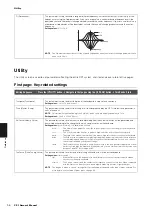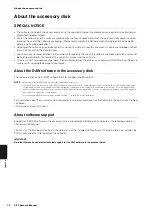
File
CP1 Owner’s Manual
61
R
eference
Third page: Loading files from a USB flash-memory device
CAUTION
Whenever data is loaded from a USB flash-memory device, all data at the specified destination will be overwritten. It is wise, therefore, to
regularly create backup copies of important data on a USB flash-memory device or the like.
Fourth page: Renaming files and directories
Editing Sequence:
Press the [FILE] button
Navigate to the third page using the [
L
PAGE] and [PAGE
R
] buttons
Turn
Knobs 1 and 3 to set parameters
Press the [ENTER] button
Press Knob 4 [YES]
Type (File Type)
This parameter is used to specify the type of file to be loaded into the CP1.
Setting values:
all, perf (Performance), or external
all..................The entire content of the User Memory (with the exception of External Performances) will be
overwritten with the content of the selected file, which must have the file extension “.C1A”.
perf...............A single User Performance from the selected User Memory file (which must have the file
extension “.C1A”) will be loaded into the specified location in the User Performance memory.
In order to select the Performance to be loaded and the Performance to be overwritten,
press the [ENTER] button with “perf” selected. Select the Performance to be loaded from the
USB flash-memory device using Knobs 2 and 3; select the CP1 User Performance to be
overwritten using Knobs 4 and 5. Specifically, Knobs 2 and 4 are used to select a bank (i.e.,
USR A, USR B, or USR C), while Knobs 3 and 5 are used to select a program number (all or
1 to 16).
external ........An entire External Performance memory will be loaded (from the file named
“EXTBANK.C1E”).
NOTE
Type can be set to “external” only when the USB device’s root directory is selected using the
File
parameter.
Load screen when “perf” is selected
File
This parameter is used to select the file to be loaded. To move down into a subdirectory (i.e., to open a
folder), turn Knob 3 to select that subdirectory (i.e., “
directory name
|DIR”), and then press the [ENTER]
button. To return from a subdirectory (i.e., to close a folder), turn Knob 3 to select “updir”, and then press
the [ENTER] button. If
Type
has been set to “external”, the
File
parameter will be automatically set to
“EXTBANK.C1E”.
Editing Sequence:
Press the [FILE] button
Navigate to the fifth page using the [
L
PAGE] and [PAGE
R
] buttons
Turn
Knobs 3, 5, and 6 to set parameters
Press the [ENTER] button
File
This parameter is used to select the file or directory to be renamed. To move down into a subdirectory (i.e.,
to open a folder), turn Knob 3 to select that subdirectory (i.e., “
directory name
|DIR”), and then press the
[ENTER] button. To return from a subdirectory (i.e., to close a folder), turn Knob 3 to select “updir”, and then
press the [ENTER] button.
Cursor
Knob 5 can be turned to move the cursor within the file or directory name. Furthermore, each file or
directory name can be up to 8 characters in length.
Data
Knob 6 can be turned to change the character at the current cursor position.
Setting values:
Upper case letters ............ ABCDEFGHIJKLMNOPQRSTUVWXYZ
Numbers and symbols ...... 0123456789!#$%&'()-@^_`{}~
USRA:01
USRA:01
Load>
[A
a
orm
N
1
P
l]
[
>
A
a
orm
N
1
P
l]
3
Performance to be loaded from User Memory file
Performance on CP1 to be overwritten
Bank selected using Knob 2
Performance number
selected using Knob 3
Bank selected using Knob 4
Performance number
selected using Knob 5






























